Judi Lynn
Judi Lynn's JournalYour information carries so much weight! I am so grateful to have learned the name of this man,
the new fascist tyrant, and sadist, greedy, murderous criminal who's the extension of Branko Marinkovic, connected through his traitorous parents to the Croatian Nazis. Branko Marinkovic was for so long active in organizing and operating the gangs of violent right-wing racist white storm troopers, down to handing out clubs and bats from his office to gangster walk-ins.
They periodically go on rampages, clobbering and beating stuffings out of "####ing Indians" they see on the streets, or driving directly to their neighborhoods on the outskirts of towns and destroy everything in their paths there.






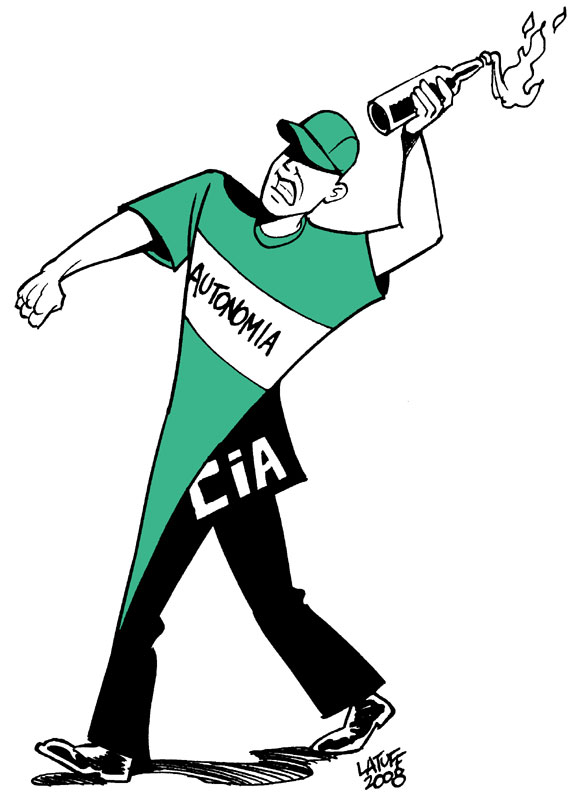
Here's an article written in 2008, and it will show nothing has changed beyond intensification of the open violence by the nazi youth movement, even though the standard of living has improved steadily for the great majority of the poor, and downtrodden, right in their own homeland, indigenous people, the native Bolivians.
ABIDING IN BOLIVIA
CARAJO
http://casa-del-duderino.blogspot.com/2008/09/santa-cruz-republica-de-mierda.html
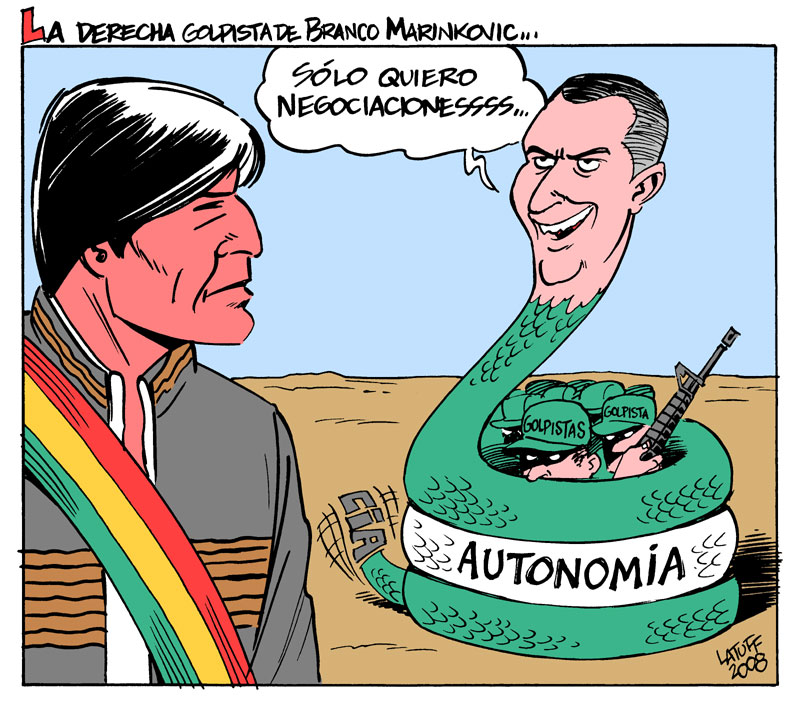

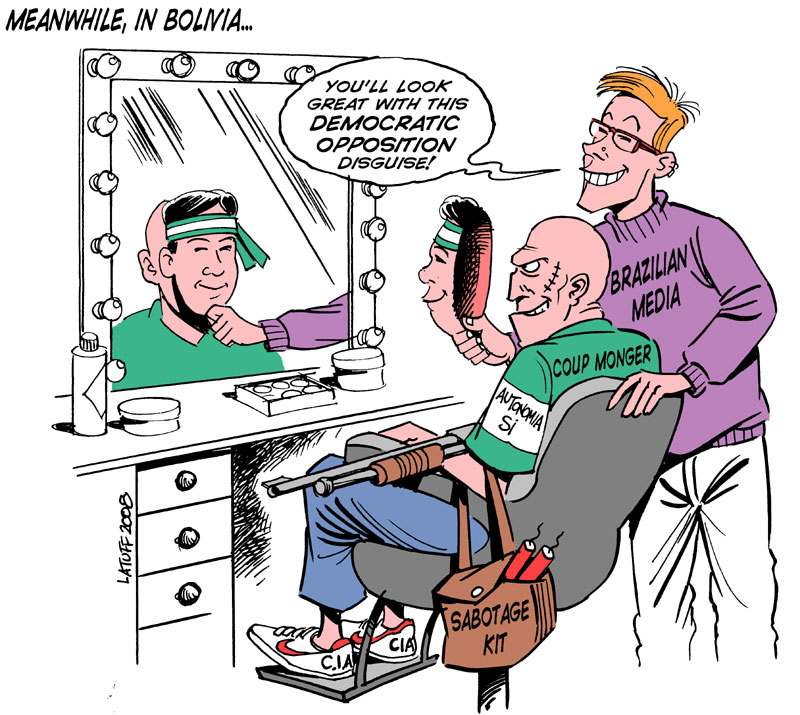

I just found the following article, doing a search for Camacho and Marinkovic:
Google translate:
They reveal that Camacho is transported in Marinkovic's vehicle in La Paz
07 NOVEMBER 2019 19:09 H.

Éxito Noticias, November 7, 2019.- The Minister of Government, Carlos Romero, in contact with radio Éxito revealed that the civic leader from Mendoza Luis Fernando Camacho who arrived at the Government headquarters last Wednesday night is transported in a vehicle of Mr. Branko Marinkovic and questioned the proceeding of the resources with which this campaign of “destabilization” of the Government is solved.
"Do you know that the car in which it moves is Branko Marinkociv? If it is in the car of Branco Marinkovic, a separatist who at the time invented the theory that you change them are superior and lower collas and that you had to leave this country in two, this Mr. Camacho moves in his vehicle. Look, we are giving him security and God wants nothing to happen, hopefully it will not provoke, ”Romero said.
Marinkovic, the former president of the Pro Santa Cruz Committee and accused of the Terrorism case fled the country and is currently investigated because the commission detected 14 offshore companies belonging to his family and was syndicated as one of the main suspects in financing a group of mercenaries to try to divide Bolivia in 2009
“We have made many mistakes, but from there to make a political turn to be part of a conspiracy. In a conspiracy that has so much money, Someone ask yourself, how much does this mobilization cost each day? 100 thousand dollars out there is short, ”said the minister questioning the cost of sustaining this mobilization for 15 days of uninterrupted unemployment.
Romero reproached the attitude of the civic leader who once said that: "The government minister who looks after his president I do not need to protect me," and now he is protected by his integrity at the seat of government, "imagine the intolerance of such arrogant, arrogant people we are dealing with, ”the authority concluded.
https://www.exitonoticias.com.bo/articulo/politica/romero-revela-camacho-transporta-vehiculo-marinkovic-paz/20191107190954042023.html
Thank goodness for your information. It gives us so much more to keep in mind. The new name clearly is powerful already. Thank you, and thank you, sandensea.
Salvadoran massacre victims still hunting 'truth and justice' 38 years later
NOVEMBER 9, 2019 / 2:04 PM / UPDATED 11 HOURS AGO
Nelson Renteria
4 MIN READ
CACAOPERA, El Salvador (Reuters) - Fidel Perez has abandoned his farm for the day to look on as investigators work in a remote cemetery in this Central American country, seeking answers to one of many tragedies in the Salvadoran civil war - and the remains of his mother and sister.
For Perez, now 43, the investigation marks a return to a dark day when he was seven years old, huddled in a cave with his family and neighbors. Then soldiers threw in a grenade.
It was December 1981, during a military operation in Morazan, at the dawn of the long and bloody civil war that claimed tens of thousands of lives.
Perez fainted in the explosion. When he regained consciousness, he saw that his mother and sister had been killed in the attack, along with 10 others.
. . .
According to a U.N. report, soldiers tortured and executed more than a thousand residents of El Mozote and surrounding hamlets in the Morazán department, 180 km (110 miles) northeast of San Salvador, as they searched for guerrillas in December 1981.
More:
https://www.reuters.com/article/us-elsalvador-politics/salvadoran-massacre-victims-still-hunting-truth-and-justice-38-years-later-idUSKBN1XJ0H8?rpc=401&
~ ~ ~
Wikipedia:
The El Mozote Massacre took place in and around the village of El Mozote, in Morazán department, El Salvador, on December 11, 1981 when the Salvadoran Army killed more than 800 civilians[1] during the Salvadoran Civil War. The El Mozote massacre was preceded by the Indigenous Genocide massacre of 1932, the Student massacre of 1975, and the Óscar Romero funeral massacre and Sumpul River massacre in 1980. It was followed by the El Calabozo massacre in 1982, the Tenango - Guadalupe massacre and Tenancingo - Copapayo massacre in 1983, and the Guaslinga - Los Llanitos massacre in 1984.
In December 2011, the Salvadoran government apologized for the massacre,[2] the largest in Latin America in modern times.[3]
. . .
December 11 and 12
Early the next morning, the soldiers reassembled the entire village in the square. They separated the men from the women and children and locked them in separate groups in the church, the convent, and various houses.[9]
During the morning, they proceeded to interrogate, torture, and execute the men in several locations.[10] Around noon, they began taking the women and older girls in groups, separating them from their children and murdering them with machine guns after raping them.[11] Girls as young as 10 were raped, and soldiers were reportedly heard bragging how they especially liked the 12-year-old girls.[12] Finally, they killed the children at first by slitting their throats, and later by hanging them from trees; one child killed in this manner was reportedly two years old.[13] After killing the entire population, the soldiers set fire to the buildings.
The soldiers remained in El Mozote that night but, the next day, went to the village of Los Toriles and carried out a further massacre. Men, women, and children were taken from their homes, lined up, robbed, and shot, and their homes then set ablaze.[14]
Initial reports and controversy
News of the massacre first appeared in the world media on January 27, 1982, in reports published by The New York Times[15] and The Washington Post. Raymond Bonner wrote in the Times of seeing "the charred skulls and bones of dozens of bodies buried under burned-out roofs, beams, and shattered tiles".[15] The villagers gave Bonner a list of 733 names, mostly children, women, and old people, all of whom, they claimed, had been murdered by government soldiers.[15][16]
Alma Guillermoprieto of the Post, who visited the village separately a few days later, wrote of "dozens of decomposing bodies still seen beneath the rubble and lying in nearby fields, despite the month that has passed since the incident... countless bits of bones—skulls, rib cages, femurs, a spinal column—poked out of the rubble".[17]
Both reporters cited Rufina Amaya, a witness who had escaped into a tree during the attack. She told the reporters that the army had killed her husband and her four children, the youngest of whom was eight months old, and they lit the bodies on fire.[15]
Ruins of a burned building.
Salvadoran army and government leaders denied the reports and officials of the Reagan administration called them "gross exaggerations".[17] The Associated Press reported that "the U.S. Embassy disputed the reports, saying its own investigation had found... that no more than 300 people had lived in El Mozote."[16]
More:
https://en.wikipedia.org/wiki/El_Mozote_massacre
~ ~ ~
Research and The Massacre at El Mozote: How the U.S. justified its support for the Salvadoran Military
By Rachel BierlyMarch 7, 2019

There is no justification to murder civilians in any circumstance. However, perhaps just as heinous a crime is to support any individual or organization who commits these murders or look the other way when they are committed. This is what the United States did under the Raegan Administration in the 1981 massacre at El Mozote. In Mark Danner’s collection of accounts and analysis of this massacre in his book titled The Massacre at El Mozote, he discusses the way in which the U.S let its fear of communism rationalize its action of strategically overlooking the horror that was invoked upon El Mozote. The U.S. played a tremendous role in allowing these tragic human rights violations to happen through monetary and weapons provisions, the U.S. training of Salvadoran military members, and the ignorance and discrediting of research.
Following the successful left-wing Sandinista movement in Nicaragua, the U.S. fought actively to achieve its goal of preventing communism regimes. When left-wing guerilla groups formed the Farabundo Marti National Liberation Front (FMLN) in El Salvador, the U.S. helped to fund the Salvadoran military, provide arms for soldiers, and train Salvadoran troops. Members of the Atlacatl Battalion were trained by U.S. Special Forces (38) and the battalion was assigned at least 10 American advisors (119). The U.S. was practiced at supporting regimes sympathetic to U.S. goals, though arguably without success (e.g. 1954 CIA intervention in Guatemala, 1961 Bay of Pigs Invasion). Therefore, the U.S. should have been aware of the potential catastrophes of under-arming, under-training, or under-funding a movement.
The American training was not as “elite” as the press reported. In fact, one of the Special Forces trainers explained that members of the Atlacatl Battalion “‘had no specialized training’” (49). Without debating the ethics of U.S. support for foreign militaries, failing to properly train or support a military division had previously resulted in severe consequences. The under-trained Salvadoran soldiers were responsible for the massacre of 800 civilians at El Mozote. Consequently, the U.S. was also responsible due to its failure to sufficiently train the battalion, and for the funding and arms provided to the Salvadoran soldiers. In the aftermath of El Mozote, Danner, a notable scholar on Latin American politics and foreign affairs and author of The Massacre at El Mozote emphasized the importance of facts, and how overlooking and discounting research led the U.S. to continue allowing the Salvadoran regime to kill more innocent people.
In recent years, the veracity of facts, a phrase that would once have seemed redundant, has become controversial. It was not much different in 1981 El Salvador. The U.S. Administration dismissed research due to a lack of concrete evidence, resulting in the continued ignorance of the reality of the Salvadoran regime. Salvadoran radio station Venceremos which, though based on facts, was dismissed by the U.S. Government as nothing more than propaganda (87). William L. Wipfler, director of the human-rights office of the National Council of Churches in New York was one of the first people to research the massacre. Wipfler reached out to the U.S. Ambassador Deane Hinton, Amnesty International and other human rights organizations (86).
More:
https://www.panoramas.pitt.edu/opinion-and-interviews/research-and-massacre-el-mozote-how-us-justified-its-support-salvadoran
Film probes history of Native Americans in the US military
Russell Contreras, Associated Press
Updated 10:49 am CST, Saturday, November 9, 2019

Photo: Jeff Robbins, AP
IMAGE 1 OF 7
In this July 8, 1986, file photo, World War II Navajo veterans and supporters march through the reservation in a show of solidarity against giving up any of their land to the Hopis in Arizona. "The Warrior Tradition," a new film set to air on most PBS stations Monday, Nov. 11, 2019, examines the history of Native Americans in the U.S. military since World War I.
ALBUQUERQUE, N.M. (AP) — Before Chuck Boers joined the U.S. Army, the Lipan Apache member was given his family's eagle feathers. The feathers had been carried by his great-great-great-grandfather on his rifle when he was an Apache scout.
They also were carried by relatives who fought in World War I, World War II, Korea and Vietnam. In 2004, Boers had the feathers with him during the Battle of Fallujah in Iraq. "I felt like I had my family with me to protect me," he said.
"The Warrior Tradition," a new film set to air on PBS, examines the complex history of Native Americans in the U.S. military since World War I and how their service transformed the lives for Native Americans from various tribes. Through interviews with veterans and using archival footage, the documentary probes the complicated relationship Native Americans had with military service and how they used it to press for civil rights.
. . .
At the onset of World War I, the first generation of Native Americans after the so-called Indian Wars began joining the U.S. Army even though they weren't considered citizens or allowed to vote. Returning veterans, and also those from World War II, earned accolades for their service. For example, Comanche and Navajo Code Talkers in World War II were credited with passing secrets amid hostile fighting.
The returning veterans began demanding the right to vote and fought against discrimination. For example, Miguel Trujillo Sr., a Marine sergeant in World War II and a member of Isleta Pueblo in New Mexico, returned and waged a legal battle to overturn that state's law that barred American Indians living on reservations from participating in elections.
More:
https://www.chron.com/news/us/article/Film-probes-history-of-Native-Americans-in-the-US-14822599.php
This Bobtail Squid Might Be the Cutest Thing in the Ocean
JULY 2, 2019

© DOUG PERRINE / SEAPICS.COM
Katie Hogge
AUTHOR
Gather ‘round, ocean lovers…we found it. We found what we’re pretty positive could be the cutest cephalopod in the entire ocean, and its name is the Hawaiian bobtail squid (Euprymna scolopes). From their favorite foods to their BFF status with a special little set of bacteria, check out these six things to know about one of the most adorable invertebrates in the entire ocean: the Hawaiian bobtail squid.
More:
https://oceanconservancy.org/blog/2019/07/02/bobtail-squid-might-cutest-thing-ocean/
Colombia's trial of the century: prosecution interrogates Uribe's fixer
by Adriaan Alsema November 5, 2019
The fixer of former President Alvaro Uribe returned to Colombia to be heard by prosecutors on Tuesday about his role in the alleged fraud and bribery practices of his boss.
Mafia lawyer and self-proclaimed “gangstattorney” Diego Cadena returned to Colombia on Monday to comply with the prosecution order to attend Tuesday’s 9AM hearing.
Cadena was called in for a hearing after the Supreme Court ordered the prosecution to add bribery to the growing list of crimes allegedly committed by the mafia lawyer.
. . .
The United States’ Department of Justice (DOJ) works closely with the prosecution and has reportedly refused to cooperate with the Supreme Court to gather evidence of Cadena’s alleged visits to US prisons.
More:
https://colombiareports.com/colombias-trial-of-the-century-prosecution-interrogates-uribes-fixer/
Police investigate acid attack on Milwaukee's south side as a hate crime; suspect in custody
Police investigate acid attack on Milwaukee's south side as a hate crime; suspect in custody
Sophie Carson, Milwaukee Journal Sentinel
Published 3:01 p.m. CT Nov. 2, 2019 | Updated 12:20 p.m. CT Nov. 3, 2019
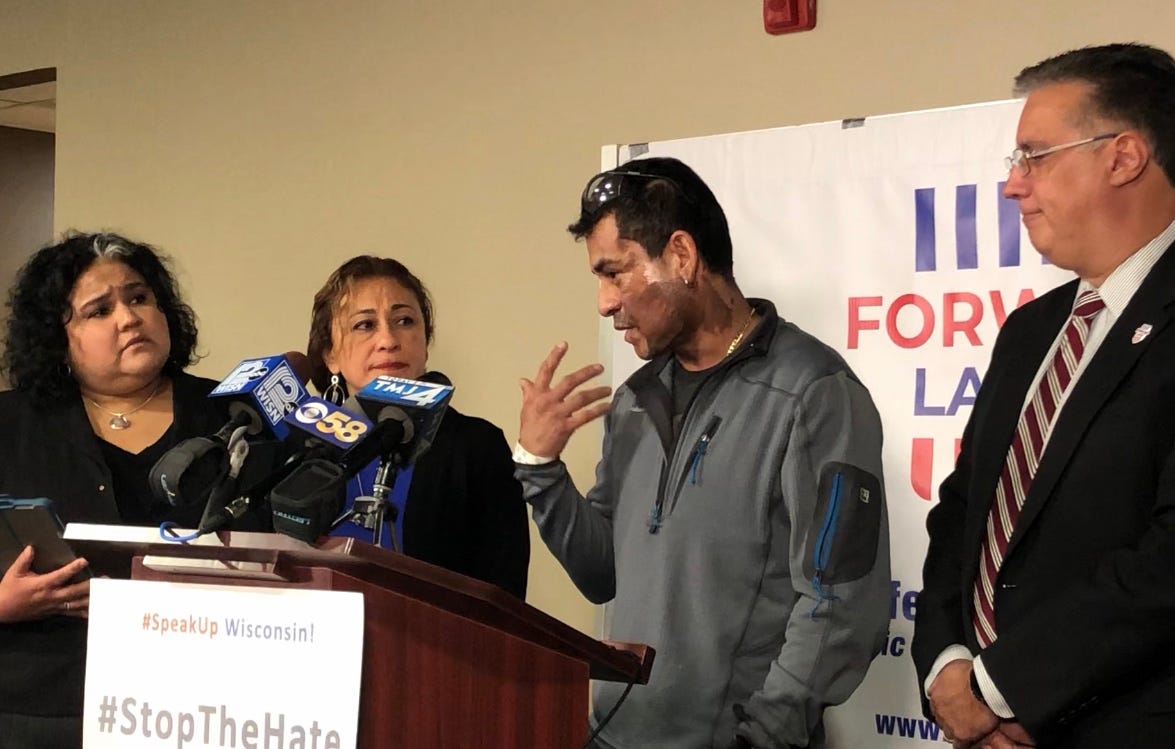
A Milwaukee man who suffered second-degree burns to his face in an acid attack Friday said Saturday he's now scared to walk around in his own city.
Mahud Villalaz, 42, on Saturday remained stunned by his encounter on Milwaukee's south side with a man at a bus stop who began berating him and then threw acid onto his face from a metal bottle.
Police said early Sunday that they had arrested a 61-year-old man in connection with an "aggravated battery" near the same location on Friday.
Villalaz's family released a statement thanking police for an arrest in the case.
"We wish to thank Chief Alfonso Morales and all the professionals at the Milwaukee Police Department for their efforts in bringing the attacker to justice," the statement reads.
On Saturday Villalaz said he no longer felt safe.
"I feel scared being an American citizen. I feel scared that I cannot feel protected in my own country with my neighbors," Villalaz told reporters at a news conference Saturday where he spoke in both Spanish and English.
More:
https://www.jsonline.com/story/news/local/2019/11/02/milwaukee-battery-acid-attack-man-burned-police-looking-suspect/4140669002/
Public Prosecutor Says Doorman Falsely Cited Bolsonaro's Name in Marielle Case
Prosecution says reasons behind concierge report will be investigated
Oct.31.2019 1:02PM
Ana Luiza Albuquerque
Italo Nogueira
RIO DE JANEIRO
The Rio de Janeiro Public Prosecutor said on Wednesday (30) that a doorman gave false information when quoting President Jair Bolsonaro (PSL) in a testimony given during the investigation of the death of Councilwoman Marielle Franco (PSOL) and her driver, Anderson Gomes
Prosecutor Simone Sibilio initially said that the employee of the condominium where Bolsonaro has a home in Rio lied. She later said that the information he provided "is not compatible with the technical evidence."
"Why the porter gave a statement will be investigated. If he lied, made a mistake or forgot," Sibilio said.
Globo's Jornal Nacional television show reported on Tuesday that a doorman (whose name was not revealed) testified that Élcio Queiroz, a former military police officer suspected of involvement in the crime, told him on the day of the murder he was going to Bolsonaro's house, then a federal deputy.

(FILES) In this file photo taken on February 21, 2018 This handout photo released on March 16, 2018 by Rio de Janeiro's Municipal Chamber shows Brazilian councilwoman from the left-wing party PSOL Marielle Franco, leading a session at the Municipal Chamber in Rio de Janeiro. - - - - From Brazil, murdered political activist Marielle Franco made the list jointly with tribal chief Raoni Metuktire, who campaigns against the destruction of the Amazon rainforest, and rights defender Claudelice Silva dos Santos. (Photo by Renan OLAZ / Rio de Janeiro Municipal Chamber / AFP) - AFP
. . .
On Tuesday, Bolsonaro to made an aggressive and angry social media broadcast with attacks on Globo and Rio Gov. Wilson Witzel (PSC).
More:
https://www1.folha.uol.com.br/internacional/en/brazil/2019/10/public-prosecutor-says-doorman-falsely-cited-bolsonaros-name-in-marielle-case.shtml
(In this episode, Bolsonaro has attacked a very pro-Bolsonaro paper which reported information which connects someone in Bolsonaro's household with one of the suspected assassins, one of these guys:

Arrest of Murder Suspects in Rio Spotlights Bolsonaro Family
By Bruce Douglas
March 12, 2019, 2:27 PM CDT Updated on March 12, 2019, 4:18 PM CDT
Two men arrested on Tuesday for killing of Marielle Franco
Black, leftwing lawmaker Franco was assassinated one year ago
Brazil’s President Jair Bolsonaro and his sons were in the spotlight on Tuesday over their ties with two suspected killers, reviving a sense of unease over his administration.
The day started with a police raid on the gated community in Rio de Janeiro where the president lives. One of his neighbors, a former police officer, was arrested for the murder of Marielle Franco. The assassination of Franco, a black legislator and human rights activist, shocked and divided Brazil in the run-up to last year’s violent and bitterly contested elections.
The police officer in charge of the investigation, Giniton Lages, said on Tuesday that the fact the alleged killer lived near the president was "not significant at this time". But in response to a journalist’s question he acknowledged that one of the president’s sons had dated the suspect’s daughter.
In a separate raid in another part of the city, police arrested a second man for the killing of Franco. Brazilian media, including Folha de S. Paulo, subsequently published a photo of this suspect, Elcio Queiroz, in a friendly embrace with the president. They attributed the image to Queiroz’s Facebook account.
More:
https://www.bloomberg.com/news/articles/2019-03-12/photo-of-brazil-president-with-murder-suspect-in-media-spotlight
~ ~ ~
Former police officers in Rio charged with politician’s murder
City council member Marielle Franco was shot four times in 2018
Tue, Mar 12, 2019, 19:01
Tom Hennigan in São Paulo

Two former police officers in Rio de Janeiro were charged on Tuesday with the killing of city council member Marielle Franco and her driver a year ago this week.
Retired police officer Ronnie Lessa (48) and Élcio Vieira de Queiroz (46), who was expelled from the force in 2015, were detained on Tuesday morning after being charged with the murders by investigators.
A highly articulate politician who was gay, black and from one of Rio’s shantytowns, Ms Franco was shot four times in the head from a car which pulled alongside the one she was travelling in. Three bullets hit her driver Anderson Gomes, who also died. An assistant to Ms Franco survived the attack.
Mr Lessa, accused of being the gunman, was arrested in the gated community in the west of Rio where Brazil’s far-right president Jair Bolsonaro also lives. Mr Queiroz is named as his driver.
Shortly after the arrests were announced a photo circulated on social media which showed Mr Queiroz alongside Mr Bolsonaro just days before the first round of the presidential election, six months after the killings. He had been expelled from the force for working security at a clandestine casino in the city.
More:
https://www.irishtimes.com/news/world/former-police-officers-in-rio-charged-with-politician-s-murder-1.3823439
~ ~ ~

Elcio Vieira de Queiroz and Ronnie Lessa, former police officers suspected of participating in the murder of Councilwoman Marielle Franco - 14/03/2019 (Bruna Prado / AP - Alexandre Brum / Agência O Dia / Estadão Content)
~ ~ ~
Computer translation from Portuguese:
Ronnie Lessa is head of the area militia that hid Queiroz
September 16, 2019adminAll posts,Latest News
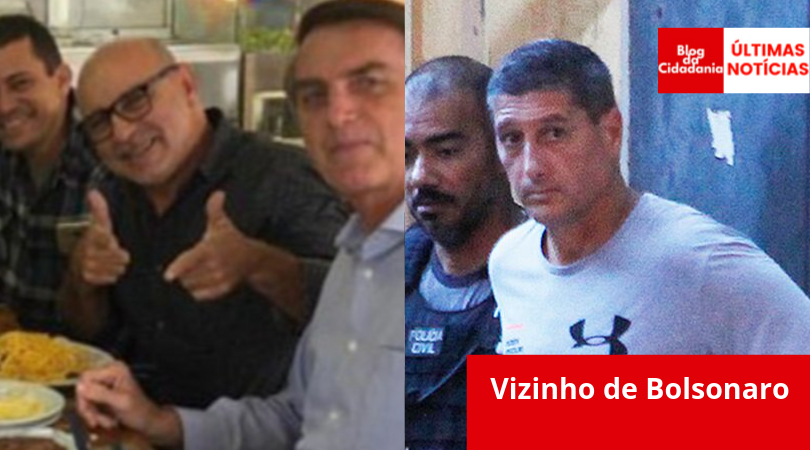
Photos: reproduction
Military Police Reserve Sergeant Ronnie Lessa, accused of killing Councilwoman Marielle Franco and driver Anderson Gomes, is a militia chief in the west of Rio de Janeiro, owned a clandestine bingo in Barra da Tijuca and planned before being arrested, expand its water distribution business to areas dominated by Rio's drug traffickers.
The information is contained in a report by the Security and Intelligence Coordination of MP-RJ (Rio de Janeiro State Public Prosecutor), which served as the basis for the request accepted by the Rio Justice to transfer Lessa to the federal penitentiary system.
Lessa was arrested on March 12, along with former PM Elcio Vieira de Queiroz, who was accused of driving the used car in the bombing.
At the house of a friend of the retired sergeant, civilian police made the biggest arrest of rifles in the history of Rio de Janeiro.
. . .
Head of Militia
Rio's police intelligence system officials appoint Lessa as one of the chiefs of the paramilitary group active in the communities of Rio das Pedras and Gardênia Azul, both in the west of the capital.
"The group led by Ronnie would have ties with misdemeanors who exploit slot machines, as well as other organizations, such as militias and extermination groups," reads the MP-RJ report.
The document cites at least four active military police officers who would be part of the accused's group of murdering Marielle.
“The criminal organization of which Ronnie Lessa is a part is made up of individuals who have been committing various crimes for years… including willful crimes against life.”
Rio das Pedras is a militia-dominated community whose armed wing is known as the Crime Office: a group of hired killers whose main clients are the game mafia.
Water sale
Ronnie Lessa, according to investigations, also has water gallon distribution businesses, one of the militia's favorite branches of activity. His partner in this venture would be another active duty military police officer.
"One of the businesses kept would be the sale of water, a seemingly legal trade that demonstrates the militia acting in imposing the business against the concept of free competition," says the report of MP-RJ.
Lessa and her partner were planning to expand water distribution depots to areas dominated by drug trafficking, such as the Lins and Mandela Complex in northern Rio, as well as the central Lapa region.
A source linked to the Marielle Case investigation told UOL that Lessa also intended to bring her distribution business to the Cidade de Deus community, a territory dominated by the Comando Vermelho faction that “borders” on militant regions.
When arrested, Lessa boasted a standard of living above her official income of $ 7,000 as reserve sergeant. He lived in a condominium in Barra da Tijuca, whose homes are valued at least $ 3 million. President Jair Bolsonaro has his residence in Rio in the same condominium.
More:
https://blogdacidadania.com.br/2019/09/ronnie-lessa-e-chefe-da-milicia-em-area-que-escondeu-queiroz/
Outrage over killing of 'forest guardian' in Brazil's Amazon
BY PAULA RAMON (AFP) 13 MINS AGO IN WORLD
Activists expressed outrage Sunday at the killing of an indigenous "guardian of the forest" in Brazil's Amazon and called on the government to thwart illegal loggers in the region.
Paulo Paulino Guajajara and another tribesman, Laercio Guajajara, were ambushed by loggers late Friday as they patrolled the Arariboia territory in the northeastern state of Maranhao.
Both men are members of the Guardians of the Forest, a group of more than 100 tribesmen who attempt to protect their land from criminal logging gangs.
Paulo Paulino was shot in the neck and died in the jungle, according to Survival International, a group that defends indigenous rights. Laercio was shot in the back but managed to escape.
. . .
Since taking office in January, Brazilian President Jair Bolsonaro has been accused of harming the Amazon and indigenous tribes in order to benefit his supporters in the logging, mining and farming industries.
. . .
The group said the right-wing president's "assault on the country's environmental agencies is putting the rainforest and the people who live there at much greater risk."
Read more: http://www.digitaljournal.com/news/world/outrage-over-killing-of-forest-guardian-in-brazil-s-amazon/article/561069#ixzz64FlGWDOP
Can foie gras ever be ethical?
As the ban on foie gras is lifted in California, campaigners continue to fight against the force-feeding of geese. But what if the geese gorged themselves voluntarily? On one farm in Spain, the birds do just that
Trevor Baker
Wed 14 Jan 2015 07.50 ESTLast modified on Thu 2 Aug 2018 14.44 EDT
There has been jubilation in many of California’s swankiest restaurants this week as, for the first time in more than two years, customers have been legally allowed to enjoy the controversial delicacy foie gras. Indeed, some chefs have revelled in their role as the “baddies” of the animal rights world, boasting on social media that they’d been stocking it all along, planning celebratory feasts on the rich, creamy duck liver and all but laughing in the faces of birds choking on their food pipes.
However, the US district court has struck down the Californian ban on selling foie gras, which came into effect in 2012, not because they have a view on whether the product is cruel, but because they decided it was unconstitutional. Individual states aren’t allowed to impose rulings on “labelling, packaging or ingredient requirements”. Strictly speaking, it is not foie gras that California banned. They banned products produced by the “force-feeding of a bird for the purpose of enlarging its liver beyond normal size”.
This may seem like a semantic point, but it could be crucial in the next legal challenge. Food law expert Baylen Linnekin, himself a defender of foie gras, quotes the Humane Society campaigner Paul Shapiro’s claim that: “Force-feeding is not an ‘ingredient’ of foie gras, since foie gras can be produced without resorting to such cruel methods.” This might cause some surprise on both sides of the debate. In France, the country where foie gras is most deeply embedded in the culture, the product is defined by law as the liver of a goose or duck fattened by a feeding tube, a process known as “gavage”. Overfeeding causes a chemical change within the liver as it stores fat cells, creating the smooth texture beloved by sybarites from the ancient Egyptians to the present day.
However, there is at least one producer who doesn’t create his foie gras by force. Spanish farmer Eduardo Sousa came to prominence when food writer Dan Barber featured him in a TED talk called The Surprising Parable of Foie Gras. Sousa produces what his fans call “ethical foie”, but which he prefers to call “natural”.
More:
https://www.theguardian.com/lifeandstyle/2015/jan/14/can-foie-gras-ever-be-ethical
Humane Decisions:
Hundreds of restaurants around the world have stopped serving foie gras because of its inherent and obvious animal cruelty.
More:
https://www.humanedecisions.com/foie-gras-cruelty/
~ ~ ~
It's horrific when people believe humane choices might interfere with their maximum satiation. No compromises, eh?
It IS a matter of depth of character, maturity, intelligence, civility. Nothing but.
Apparently some have, after reflection, decided it's better to live without a conscience.
7,000-year-old fortress wall uncovered in southern Turkey
DAILY SABAH
ISTANBUL
Published
24.10.2019
19:36

IHA Photo
A fortress wall dating 7,000 years back to the Chalcolithic Age has been unearthed at the Yumuktepe Mound in southern Turkey's Mersin province.
The Yumuktepe Mound is highly significant as a continuous settlement for 9,000 years since the Neolithic Age.
Two and a half months of excavations at the mound are coming to an end on Friday. This year's excavations, focused on the Neolithic and Chalcolithic periods, were carried out by a 30-person team led by Isabella Caneva – a professor of archeology at the University of Salento in Lecce, Italy.
Caneva said that the 7-meter fortress wall discovered this season can now be shown to the public.
While every year's excavations have provided historical insights, this year's dig produced especially "striking" Neolithic and Chalcolithic findings, Caneva said.
Caneva said the layer in Yumuktepe Mound is special in that it contains very special architecture.
The fortress wall was made with a variety of materials, including a 1.5-meter-thick support wall made of limestone at the bottom, 2 meters of well-cut stones and 3 meters of mudbrick.
More:
https://www.dailysabah.com/history/2019/10/24/7000-year-old-fortress-wall-uncovered-in-southern-turkey
Profile Information
Member since: 2002Number of posts: 160,644